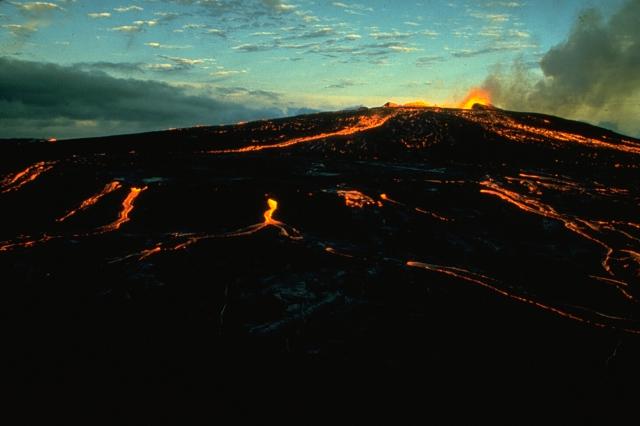Mauna Ulu on:
[Wikipedia]
[Google]
[Amazon]

 Mauna Ulu is a
Mauna Ulu is a
 The eruption that formed Mauna Ulu began on May 24, 1969 and continued until July 22, 1974. At the time, this was the longest-lasting and most voluminous eruption on Kīlauea's flank in at least 2,200 years, lasting 1,774 days and producing 350 million cubic meters of lava. Lava flowed down the sides of the feature and large
The eruption that formed Mauna Ulu began on May 24, 1969 and continued until July 22, 1974. At the time, this was the longest-lasting and most voluminous eruption on Kīlauea's flank in at least 2,200 years, lasting 1,774 days and producing 350 million cubic meters of lava. Lava flowed down the sides of the feature and large

 Mauna Ulu is a
Mauna Ulu is a volcanic cone
Volcanic cones are among the simplest volcanic landforms. They are built by ejecta from a volcanic vent, piling up around the vent in the shape of a cone with a central crater. Volcanic cones are of different types, depending upon the nature and ...
in the eastern rift zone
A rift zone is a feature of some volcanoes, especially shield volcanoes, in which a set of linear cracks (or rifts) develops in a volcanic edifice, typically forming into two or three well-defined regions along the flanks of the vent. Believed t ...
of the Kīlauea
Kīlauea ( , ) is an active shield volcano in the Hawaiian Islands. Located along the southeastern shore of the Big Island of Hawaii, the volcano is between 210,000 and 280,000 years old and emerged above sea level about 100,000 years ago. His ...
volcano on the island of Hawaii
Hawaii ( ; haw, Hawaii or ) is a state in the Western United States, located in the Pacific Ocean about from the U.S. mainland. It is the only U.S. state outside North America, the only state that is an archipelago, and the only stat ...
. It falls within the bounds of Hawaiʻi Volcanoes National Park
Hawaii Volcanoes National Park is an American national park located in the U.S. state of Hawaii on the island of Hawaii. The park encompasses two active volcanoes: Kīlauea, one of the world's most active volcanoes, and Mauna Loa, the world's mos ...
. Mauna Ulu was in a state of eruption from May 1969 to July 1974.
Etymology
The name, ''Mauna Ulu'', means "the growing mountain".1969–1974 eruption
 The eruption that formed Mauna Ulu began on May 24, 1969 and continued until July 22, 1974. At the time, this was the longest-lasting and most voluminous eruption on Kīlauea's flank in at least 2,200 years, lasting 1,774 days and producing 350 million cubic meters of lava. Lava flowed down the sides of the feature and large
The eruption that formed Mauna Ulu began on May 24, 1969 and continued until July 22, 1974. At the time, this was the longest-lasting and most voluminous eruption on Kīlauea's flank in at least 2,200 years, lasting 1,774 days and producing 350 million cubic meters of lava. Lava flowed down the sides of the feature and large lava fountain
Lava is molten or partially molten rock (magma) that has been expelled from the interior of a terrestrial planet (such as Earth) or a moon onto its surface. Lava may be erupted at a volcano or through a fracture in the crust, on land or und ...
s (Including one 539.5 meter high fountain) were witnessed. The flows formed during this time period cover 44 sq. km and some lava deposits are reported to be 7.6 meters deep. The flows destroyed parts of the Chain of Craters Road, but the damage has since been repaired and the dormant cone can be now be visited.
References
__FORCETOC__ {{Authority control Kīlauea